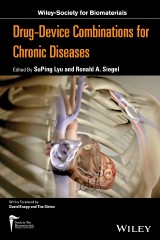Details

Drug-device Combinations for Chronic Diseases
Wiley-Society for Biomaterials 1. Aufl.
|
132,99 € |
|
| Verlag: | Wiley |
| Format: | EPUB |
| Veröffentl.: | 04.11.2015 |
| ISBN/EAN: | 9781119002970 |
| Sprache: | englisch |
| Anzahl Seiten: | 280 |
DRM-geschütztes eBook, Sie benötigen z.B. Adobe Digital Editions und eine Adobe ID zum Lesen.
Beschreibungen
<p>This book covers two areas, the first detailing the concepts and technologies of drug-device combination products. The second area includes case studies of important products that either significantly shape our technologies and thinking, or contribute to current healthcare practice.</p> The book:<br /> <ul> <li>Discusses where drugs and devices work, where they fail, and when they need to work with each other</li> <li>Reviews interactions between human bodies and the drug-device combination products the measurements of these interactions</li> <li>Covers how a drug-device combination product is developed, tested, and regulated</li> <li>Includes case studies of steroid releasing leads, AOA treated tissue heart valves, intrathecal drug delivery pumps, infuse bone grafts, drug eluting stents, and antimicrobial meshes</li> </ul>
<p>FOREWORD vii</p> <p>PREFACE ix</p> <p><b>PART I BACKGROUNDS 1</b></p> <p>1 Addressing Medical Device Challenges with Drug–Device Combinations 3</p> <p>2 Historical Survey of Drug Delivery Devices 39</p> <p>3 Development of Combination Product Drug Delivery Systems 66</p> <p>4 Drug–Material Interactions, Materials Selection, and Manufacturing Methods 89</p> <p><b>PART II PRODUCTS 117</b></p> <p>5 Steroid-Releasing Lead 119</p> <p>6 Thromboresistant Vascular Graft 142</p> <p>7 Device-Enabled Drug Infusion Therapies 182</p> <p>8 Promus Element Plus®: A Drug-Eluting Stent 214</p> <p>9 Infuse® Bone Graft 241</p> <p>INDEX 261</p>
<p><strong>SuPing Lyu</strong>, PhD, joined, is a Principal Scientist at Medtronic, Inc., and his research focuses?on drug-device combination products, biomaterials, and biomaterial-biological interactions. He is a visiting professor of the Minnesota Center for Industrial Mathematics, School of Mathematics at University of Minnesota?and has?been a guest lecturer of biomaterials for the?university since 2006. In addition to authoring over 25 peer-reviewed papers, Dr. Lyu?served as an associate editor for the <em>IEEE/EMBC 2009</em> conference. <p><strong>Ronald A. Siegel</strong>, ScD, is Professor of Pharmaceutics and Biomedical Engineering at the University of Minnesota.?He is also Program Director of the Biomaterials and Pharmaceutical Materials program of Industrial Partners for Research in Interfacial and Materials Engineering.?Professor Siegel has published over 100 papers primarily on hydrogels, drug delivery devices, microsensors, and mathematical modelling of transport. He has received several research and best paper awards from both CRS and AAPS.
<p><b>First text to focus on drug-device combinations, a rapidly emerging specialty area of medical devices </b></p> <p>Drug-device combination products have an excellent history of managing genetic, metabolic, cellular, physiologic, developmental and other diseases through chemical actions. Studies of cases tracing back to the 1980s have demonstrated how devices improved on localizing concentration of a drug, eliminating side effects which are often brought on by conventional systemic means such as infusion or oral delivery. However, drugs alone cannot directly affect mechanical diseases such as stabilizing fractured bone. Devices may treat diseases by affecting electrical, mechanical, and transport processes in the patients, but often cause side effects that are related to inflammation, proliferation, and remodelling.</p> <p>With chronic disorders such as heart disease, kidney disease, diabetes, and neurological degeneration still on the rise, discovery and development of new drugs and devices have lagged. Edited by two leading experts in the field, <b><i>Drug-device Combinations for Chronic Diseases</i></b> explores the latest advances and research in drug-device combination technology. Focused on two main areas, the book covers:</p> <ul> <li>Historical and state-of-the-art overview on how drug-device combinations improve drug release, distribution, and availability, as well as use drugs to eliminate device side effects and promote their efficiency</li> <li>Concepts and technologies of drug-device combination products</li> <li>Case studies of important products that shape our technologies, mindset and current healthcare practices</li> <li>Examples that demonstrate the effectiveness of drug-device combinations, including steroid-releasing leads, AOA-treated tissue heart valves, intrathecal drug delivery pumps, infuse bone grafts, drug-eluting stents, and antimicrobial meshes.</li> </ul> <p>The book is written to appeal to employees of big pharma companies, medical device companies, private research institutes, universities, inventors, FDA and other regulatory agency professionals. Researchers and graduates, both experienced and/or new to the field will find this monograph an invaluable source of research that enriches and cultivates a strong background in medical devices.</p>


















